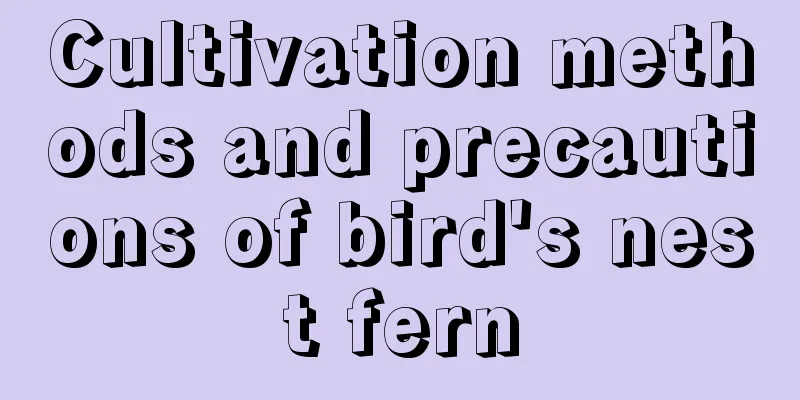Cultivation methods and precautions of bird's nest fern

|
Bird's nest fern , also known as nest fern, is a perennial herbaceous foliage plant with shiny green leaves all year round and high ornamental value. Here are some tips on growing bird's nest ferns. 1. Soil Bird's nest fern likes loose, breathable and well-drained soil. It can be planted evenly in peat soil or a mixture of coconut coir and perlite in a ratio of 2:1. You can choose a ceramic pot with good air permeability or a hanging coconut palm pot for the flower pot. After planting, water it thoroughly and place it in a cool and ventilated place for maintenance. 2. Lighting The native environment of the bird's nest fern is the understory of the tropical rainforest, where it can grow normally in scattered light. When caring for it indoors, place it in a bright place. Outdoors, you can also place it under the shade of a tree. Do not expose it to direct sunlight, as long-term exposure will burn the leaves. 3. Temperature Bird's nest fern likes a warm and humid environment. The suitable growth temperature is 16 to 27℃. It cannot be lower than 5℃ in winter. If the temperature is lower than 5℃ for a long time, it will suffer frostbite and die. When the temperature is above 30℃ in summer, provide shade and spray water to cool down. 4. Moisture The bird's nest fern has a high demand for water and must not be short of water, otherwise the leaves will easily turn yellow. Wait until the surface of the potting soil is dry and you can water it directly. When the temperature is usually high or humid, you need to spray the area around the plants frequently to increase the humidity, which helps keep the leaves green. After watering and spraying, pay attention to ventilation of the maintenance environment, otherwise anthracnose is likely to occur. 5. Fertilization The bird's nest fern does not have a high demand for nutrients and does not require frequent fertilization. Generally, you can use some liquid fertilizer during the growth period. It does not matter if you apply it once every half a month or twenty days. Usually, avoid using high-concentration fertilizers to avoid burning the seedlings. If you find that the bottom leaves are turning yellow during the maintenance process, don't worry. Yellowing of the bottom is normal. Cut off the yellow leaves in time and pay attention to the maintenance environment mentioned above. New leaves will soon grow from the middle. 6. Notes When the bird's nest fern grows to maturity, it will grow sub-plants (side branches) next to the mother plant. When the sub-plants grow a little bigger, they can be separated. The separated sub-plants should be placed in a ventilated and shaded place, and should be kept moisturized and ventilated, maintaining a high air humidity. Only after it grows new leaves can normal maintenance be resumed. That’s it |
<<: What is the planting season for Polygonatum sibiricum?
>>: When is the best time to plant tomatoes?
Recommend
What is the method of planting pomegranate potted plants? Can pomegranate seeds be planted in small pots?
1. Can pomegranate seeds be planted in small pots...
The flower language and meaning of spring
The origin of the name of Duzhanchun Duzhanchun i...
When is the best time to plant spinach?
Spinach is an annual herbaceous plant belonging t...
How to propagate lavender and what to pay attention to
How to propagate lavender The main methods of lav...
When is the best time to sow black sesame seeds?
Suitable time for sowing black sesame Black sesam...
When is the best time to plant lilies?
1. Autumn Planting August to September in autumn ...
Can mirror grass be hydroponically cultivated? Is hydroponics better or soil cultivation better?
Can mirror grass be grown hydroponically? Mirror ...
Where is it suitable to grow avocado?
Where avocados are grown Generally, avocado grows...
How to grow Epiphyllum quickly
1. Good soil Soil is very important, and the main...
How to prune potted figs
time Pruning can be done in early spring, after a...
How to water flowers with rice water
1. About nutrients In fact, rice water is usually...
Can tiger lily be placed in the living room?
1. Can be placed Sansevieria can be placed in the...
Can I grow bayberry trees at home?
Can I grow bayberry trees at home? You can plant ...
Can rice water be used to water spider plants?
1. Can be poured Rice water can be used to water ...
Is the cashew yield high? What is the yield per mu?
Is cashew nut production high? The yield of cashe...









